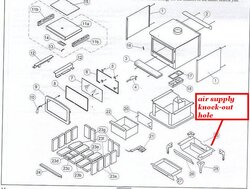MountainStoveGuy said:
Im a fan of the passive kits, like the condar asv-90. Good link tradergordo, thats exactly what was happening to my customers, The outside air was on the east side of the house with a marginal chimney. Wind blows here usually from west to east. The installed it against my recomendation and then had the guts to call me and tell me my stove i sold them was broken (Jotul Oslo). There exact words "this stove shouldnt send smoke and sparkes out the side of my house, i want my money back". Thats exactly what they got, i didnt argue a bit, i explained the problem was the outside air kit, they didnt believe a word i said. I picked it up the next day to avoide getting into a lawsuit when there house burnt down.
Hah! You should send them a copy of that report. They probably bought another stove from someone else and had the same problem. What a shame. Yes, these outside air kits are dangerous.
p.s. The passive kits don't work either!
Passive make-up air supplies
A passive make-up type air supply is one that is not connected directly to the fireplace or stove combustion chamber. Since it is connected only to the house environment and not to the appliance, it flows air into a house only when the pressure inside is lower than the pressure outdoors, since air only flows to zones of lower pressure. Passive air supplies don't make wood burners work better, they just make the house leakier.
Passive air inlets are nothing more than holes in the wall. Wind effects may force air into the house or suck it out of the house, depending on the location of the hole relative to wind direction.
Wind effects around the house also affect the direction and volume of flow through a passive inlet. If the weatherhood of a passive inlet is on the windward side of a building, wind pressure is likely to force air into the building; if the weatherhood is on the downwind side, the negative pressure zone created by the wind is likely to draw air out of the house, possibly depressurizing it.
More importantly, it is misleading to think of the hole in the wall approach as supplying combustion air. In fact, passive air supplies provide air only in response to pressure differences. In cold weather, when temperature difference produces a pressure difference due to stack effect, if a passive make-up air supply is located below the neutral pressure plane of the house (and there is no wind effect and no exhaust systems are operating), air will flow into the house. If, on the other hand, the passive inlet is located above the house neutral pressure plane, air will flow out.
Passive air inlets do not supply combustion air, but flow air only in response to pressure differences. Here, the flow direction depends on where in the house the passive hole is located.
It is useful to keep in mind a key physical principle:
AIR FLOWS TO ZONES OF LOWER PRESSURE through any available opening.
The real problem with the passive make-up air strategy is that it does not reliably supply combustion air, nor does it reliably reduce combustion spillage.
Under favorable conditions it may tip the balance of driving and adverse pressures in favor of successful venting. This is why some fireplace specialists have reported performance improvements after the installation of a passive supply. However, it is also possible for a passive supply to cause spillage if air is drawn out of the house into a low pressure zone caused by wind effects. A remedial strategy that only works sometimes, and that may make the problem worse, is not a good strategy. A passive make-up air supply is really nothing more than another uncontrolled leak in the house envelope. A leaky house envelope is no guarantee of successful venting.


 . As I said, the area around my fireplace got quite cold from the outside air.
. As I said, the area around my fireplace got quite cold from the outside air.